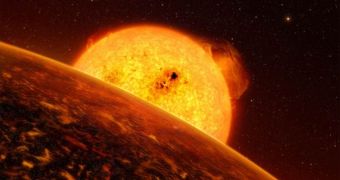One of the most Earth-like planets ever discovered, called CoRoT-7b, is most likely the only object known to be part of a category of celestial bodies called evaporated remnant cores. According to astronomers who have studied the exoplanet, its rocky nature is very peculiar given the distance it orbits from its parent star, just 1.6 million miles, or 2.5 million kilometers. That is 60 times closer than the Earth is to the Sun. Therefore, they suggest, it may be that the planet was originally larger, maybe Neptune-like, and that it shed its outer atmospheric layers, leaving behind only its tough core.
“The first planets detected outside our solar system 15 years ago turned out to be enormous gas-giants in very tight orbits around their stars. We call them 'hot Jupiters,' and they weren't what astronomers expected to find. Now, we're beginning to see Earth-sized objects in similar orbits. Could there be a connection?” NASA Goddard Space Flight Center (GSFC) expert Brian Jackson asked. He presented the idea yesterday in Washington DC, at the 215th meeting of the American Astronomical Society (AAS).
“CoRoT-7b is almost 60 times closer to its star than Earth, so the star appears almost 360 times larger than the Sun does in our sky,” Jackson explained. This close proximity, added to the fact that the star and the planet were tidally locked, led experts to conclude that the surface temperature on the day side reached as much as 2,200 degrees Celsius (4,000 degrees Fahrenheit). On the other hand, astronomers estimate that temperatures go as low as minus 210 degrees Celsius, or minus 350 degrees Fahrenheit.
“But with such a high dayside temperature, any rocky surface facing the star must be molten, and the planet cannot retain anything more than a tenuous atmosphere, even one of vaporized rock,” the expert added. He also said that the excessive heat that CoRoT-7b was subjected to might have already cooked a few Earth masses' worth of material from the planet. The research team used a number of computer models to “turn back the clock on the planet's evolution” and tracked its mass loss and orbital changes.
The studies showed that the planet might have as many as 100 Earth masses, which means that it was about as large as Saturn – a gas giant. This makes sense when considering that the exoplanet was about 50 percent further from its parent star than it is today. “You could say that, one way or the other, this planet is disappearing before our eyes,” Jackson said.
“CoRoT-7b may be the first in a new class of planet – evaporated remnant cores. Studying the coupled processes of mass loss and migration may be crucial to unraveling the origins of the hundreds of hot, Earth-like planets space missions like CoRoT and NASA's Kepler will soon uncover,” he concluded. CoRoT-7b was also recently proven to have a surface covered by more than 400 active volcanoes.

 14 DAY TRIAL //
14 DAY TRIAL //